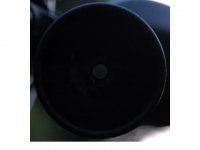Thanks for the link, Dennis. I've read Ed's reviews.
Notice that Ed doesn't actually measure field curvature in those reviews. Anybody, including you, can measure the field curvature of the 8x32 SE quite easily, because the right eyepiece diopter adjustment hash marks are at approximately 1 diopter increments. To measure the field curvature simply place an object at the bottom edge of the field of the right side and carefully focus using only the right eye. Then, still using only the right eye, move the object to the center and carefully refocus using the diopter adjustment ring, not the center focus knob. Now count how many hash marks difference there is between focus at the edge and focus at the center.
I used the word "fine" for the excellent Nikon coatings just to indicate that the coatings are no problem. What limits the 8x32 SE's resistance to stray light is a partly unbaffled objective edge. The photo below shows the exit pupil of an 8x32 SE taken at twilight. The binocular is pointing into dark foliage with skylight coming from above and to the right. The bright crescent of reflection at the lower left edge of the exit pupil comes from the exposed objective cell. That much reflection is not so bad compared to most binoculars, but it's not superior either. The Nikon 8x30 EII has a better baffled objective than the 8x32 SE and consequently shows less veiling glare under the same conditions of stray light.





